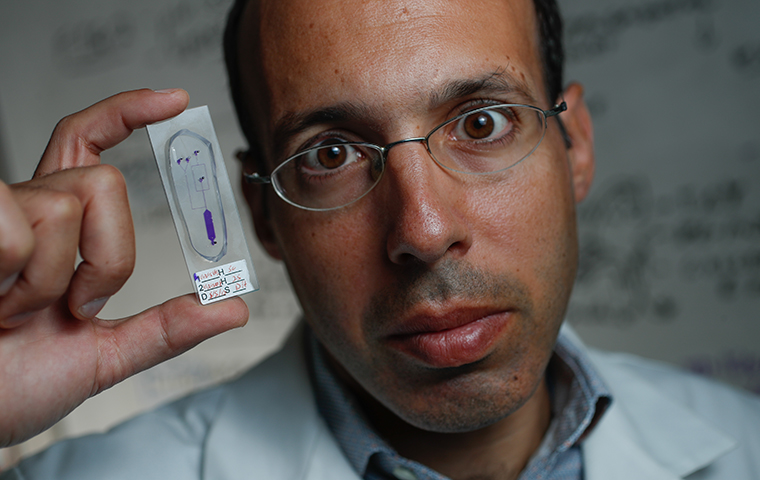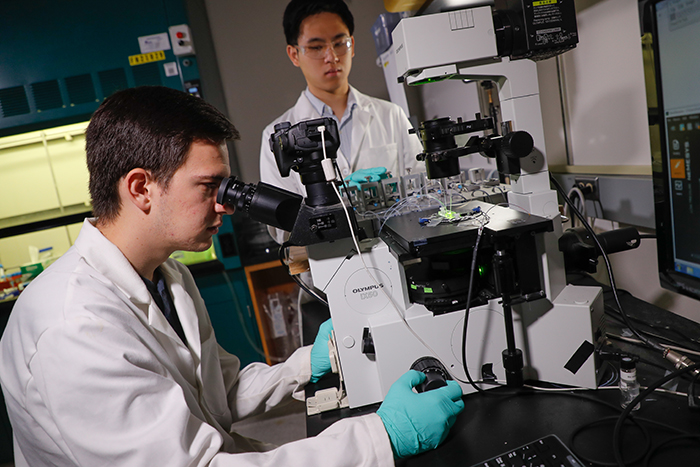
Cell by Cell
Paul Abbyad and a group of student researchers are hoping a new type of microfluidic device will help scientists learn more about the behavior of cancer cells.
In his hand, Paul Abbyad holds the research capabilities of an entire lab, all in a device about the size of a pack of gum.
In the same way electronics have benefitted from smaller and smaller components, microfluidic devices can make research more efficient by miniaturizing chemical and biological research, the associate professor says. Comprised of small channels mapped like a circuit board, each about as thick as a human hair, microfluidic devices are capable of carrying small amounts of reagents for analysis.
“What might have required a lab worker to do things—mix chemicals, make dilutions, or run an analysis on a bench top—a microfluidic device might be able to do all that within one small device,” Abbyad says.
While the technology is small, it can have a big impact, with applications that span chemistry, cell biology, and medicine. And Abbyad’s work may make them even more impactful.
Abbyad works in a subfield of microfluidics called droplet microfluidics. In droplet microfluidics, scientists form uniform water droplets in oil. The droplets of water serve as microscopic test tubes—millions in a single device—allowing for tests to be run on a single cell.

Abbyad and a group of student researchers are developing droplet microfluidic devices capable of actually sorting and analyzing those individual cells. This innovation could help scientists better understand diseases like cancer, and perhaps develop better therapies down the road.
“When you’re talking about human disease, especially a disease like cancer, where a small number of cells can have a big impact, you really have to have tools to be able to analyze at the single-cell level,” he says.
Cells, even in the same cell line, aren’t uniform, Abbyad explains. The oxygen intake, gene expression, and metabolism can vary greatly, making each unique. Cancer cells specifically tend to have high metabolic rates—one reason why they’re so draining on the body. But this isn’t true for every cell.
Abbyad’s devices will sort cancer cells by their metabolic rates so scientists can start using the techniques needed—be they related to gene or protein expression—to understand and possibly target specific cell populations. The better they understand the cells that drive cancer, the better they can treat it.
Not only will the devices have greater capabilities, but Abbyad believes they will be more cost effective and reliable. If successful, the devices could be used in different contexts to analyze various cell types and better understand the human body.
In May 2018, Abbyad received an NSF Faculty Early Career Development (CAREER) Award in the Division of Chemical, Bioengineering, Environmental, and Transport Systems (CBET). The award will support his student research team as they develop these new microfluidic devices. It will also have an educational component that helps teach young people about microfluidics.
“It really gives a big push to our research and supports a lot of research opportunities for our students,” Abbyad says of the award.
Passing it On
For the educational component of the award, Abbyad will work with Katy Korsmeyer, associate director of special projects, and Teach Biotech, a nonprofit created by the Santa Clara County Biotechnology Education Partnership (SCCBEP), to teach area high school students about microfluidics.
“It’s going to encourage students and get them excited about microfluidics and different STEM concepts,” Abbyad says. “I hope it will encourage them to continue school in a STEM field.”
The program will provide teaching kits, support information, and teacher trainings in microfluidics. It will also offer examples of how microfluidics impacts the everyday lives of students—and explain the kinds of career opportunities that exist in the field.
“Once you’ve planted the seeds of this program, it can be self-propagating, where teachers train other teachers to use the teaching kits,” Abbyad says. “In that way it can have a long-term impact in getting students excited about STEM and careers in STEM fields.”

Photo by Jim Gensheimer